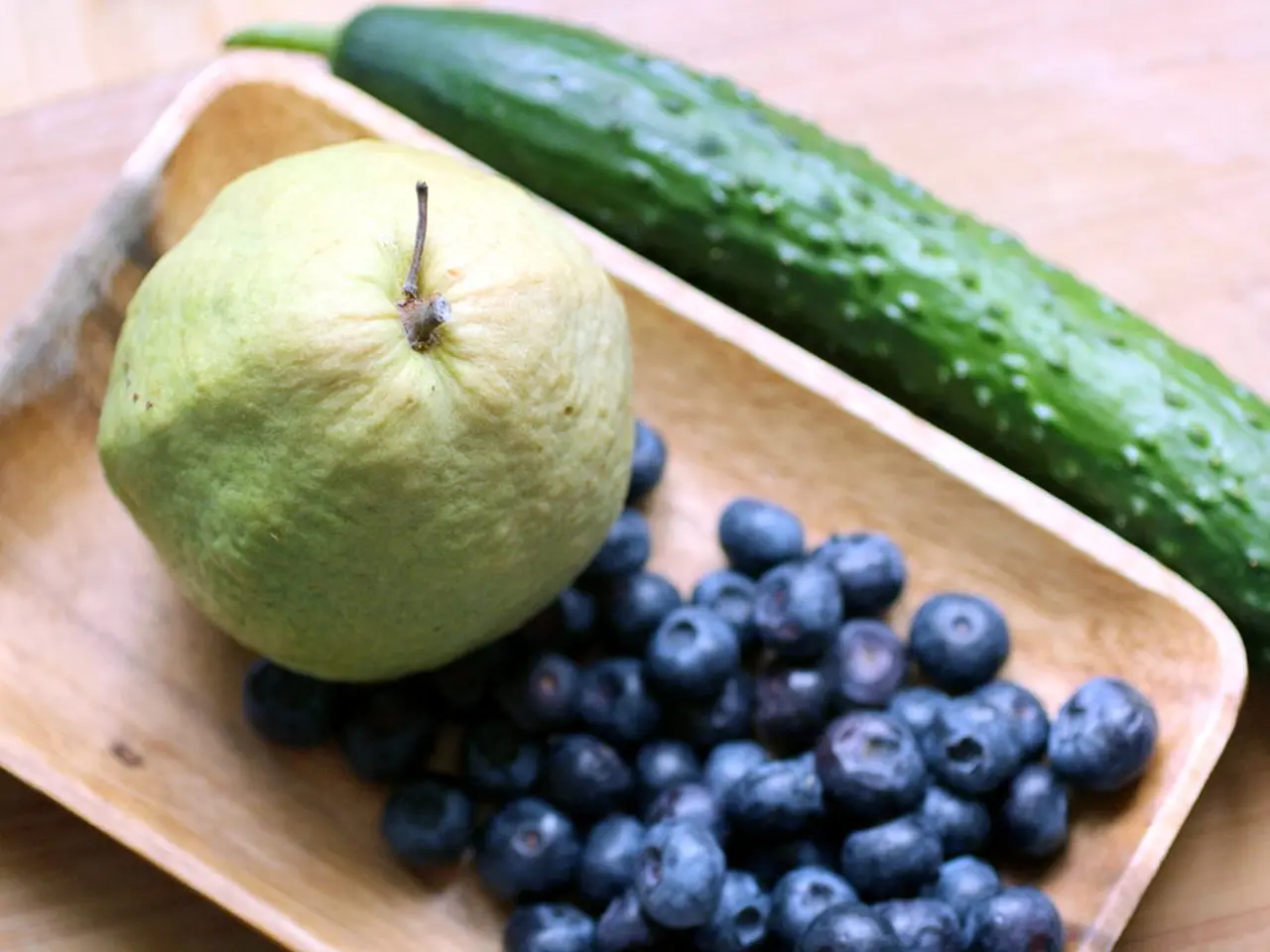Hardy Superfruit Strawberry Guava: Cultivated for Durable Agriculture and Specialty Consumption
Straying away from the common grind, the lesser-known Strawberry Guava (Psidium cattleyanum), also known as Cattley Guava, Cherry Guava, or Lemon Guava, is a passionate little treasure hailing from southeastern Brazil and parts of Uruguay. This enchanting evergreen shrub or small tree boasts vibrant red or yellow fruits and is rapidly gaining attention worldwide for its delightful taste, low-maintenance qualities, and promising potential as a niche market crop.
Now let's dive into what makes this fruit so irresistible: it sports a lush red or yellow skin, encases soft white or pinkish pulp, and bursts with a unique blend of flavors akin to strawberries, passionfruit, and classic guava. And that's not all — this tropical delight is also packed with vitamin C, dietary fiber, and antioxidants, making it a dream come true for health enthusiasts.
Yet, like many exotic beauties, its adaptability can be two-sided. In certain regions, it has turned invasive. However, with responsible cultivation, Strawberry Guava offers exciting opportunities for small farmers, urban gardeners, and aspiring agripreneurs.
Let's chat about the technicalities
Strawberry Guava typically stands tall between 2 to 6 meters, flaunting smooth, reddish-brown bark, glossy dark green leaves, and charming white flowers that blossom throughout the year in suitable climates. The flowers are pollinated by bees and last only a day. The fruit, resembling small plums or large cherries, measures around 2-4 cm in diameter and becomes ripe in red or yellow hues.
A match for every garden
Strawberry Guava thrives in tropical to subtropical climates and fares well where temperatures do not dip below -3 to -5°C. It appreciates extra sun but can handle partial shade. It knows no boundaries when it comes to soil, doing splendidly in sandy loam, clay, or even slightly rocky soils, as long as there's good drainage. Its preferred pH range lies between 5.0 to 7.5. Moderately thirsty, it's drought-tolerant once established and benefits from occasional irrigation during flowering and fruiting phases. Mulching around the base can keep moisture levels steady, suppress weeds, and modulate temperature.
Diversify your propagation plans
Propagation can be achieved via seeds, but this method fails to guarantee the consistency of fruit quality. Seeds germinate in 3 to 8 weeks, and seed-grown trees typically bear fruit after 2-3 years. For more predictable results, vegetative propagation is the way to go. Softwood or semi-hardwood cuttings, treated with rooting hormone and nurtured under high humidity conditions, will root easily. Air layering and grafting onto compatible rootstocks ensure the retention of desired traits like fruit size, sweetness, or disease resistance.
Keep it simple
Strawberry Guava is typically low-maintenance once established. Some pruning is recommended to shape the tree and boost airflow, reducing the chances of fungal issues and making harvesting a breeze. Pruning also encourages more fruit production. The plant can tolerate a few pests, such as fruit flies (mostly in tropical regions), scale insects, and birds. Preventive measures like bagging fruits, employing organic sprays, or setting traps may ward off these critters. Fertilization is minimal; applying compost or a balanced organic fertilizer twice a year, before flowering and during fruit set, often does the trick.
A fruitful harvest awaits
The tree usually begins fruiting 2-3 years after planting. The fruiting season depends on climate but usually occurs from late summer to early winter. Ripe fruits are best plucked by hand every few days since they tend to drop when mature. A mature tree can yield up to 30-40 kg of fruit per year under ideal conditions. Due to its thin skin and soft pulp, the fruit is highly perishable and should be consumed, processed, or refrigerated within a few days of harvest. Cold storage can extend shelf life by up to 1-2 weeks, but flavor peaks when fresh.
Share the love, in plenty of ways
This unassuming fruit has made quite the impression in kitchens worldwide. Its culinary versatility extends to homemade jams, jellies, fruit juices, syrups, desserts, and even fermented beverages like wines and ciders. Traditional medicine values various parts of the plant, including the leaves and bark, for treating diarrhea, sore throat, and gut woes. Scientific studies have corroborated its antioxidant, anti-inflammatory, and antimicrobial properties.
The business of strawberry guava
Despite its relatively niche status, Strawberry Guava's market potential sprouts ever brighter. With the rising demand for exotic fruits, health foods, and natural ingredients, there's a growing market for both fresh fruit and processed products. Farmers' markets, specialty grocery stores, and farm-to-table establishments can offer splendid entry points. Home gardeners and permaculturists, particularly those seeking low-input fruit crops for edible landscapes, present another promising opportunity.
Value-added products like jam, syrup, candies, or dried fruit slices can be crafted by small food entrepreneurs or cottage industries, prolonging shelf life and increasing returns. Furthermore, organic cultivation practices can catapult products to premium markets that prize clean labels and sustainable sourcing.
Tread softly, leaving footprints only on soft earth
While Strawberry Guava can provide tremendous benefits in controlled cultivation, it poses ecological challenges in certain regions, such as Hawaii, Mauritius, and parts of India, where it displaces native vegetation and alters habitats. The key to responsible cultivation is limiting its invasive nature by planting in enclosed areas, harvesting all fruits to prevent seed dispersal, pruning regularly, and avoiding use near natural forests or conservation zones. In sensitive ecosystems, consider replacing it with native or non-invasive alternatives.
Strawberry Guava is a tropical marvel that serves beauty, flavor, and sustainability under its understated charm. Its ease of cultivation, nutritional benefits, and versatility in culinary use make it an appealing choice for backyard gardens, small farms, and niche fruit markets. By implementing responsible measures ranging from propagation to marketing, this humble fruit can become a shining beacon of sustainable abundance. With the right strategies in place, it can gain recognition as a lucrative and eco-friendly crop, earning a special place in both gardens and markets alike.
First published on: 23 Jun 2025, 10:36 IST
Sources:1. Strawberry Guava: A New Exotic Fruit for Indian Climatic Conditions2. Invasive Species Compendium: Strawberry guava, Psidium cattleyanum (Myrtaceae)3. Cultivation and uses of strawberry guava4. Foliar application of humic acid improves growth of starfruit (Averrhoa carambola L.) seedlings5. Modeling the growth and berry skin properties of muscadine grapes cultured with humic substances
- Strawberry Guava, with its delightful taste and health benefits, has found a place in various lifestyle and food-and-drink sectors, making it suitable for cooking, nutrition, and health-and-wellness enthusiasts.
- Home and garden enthusiasts can also appreciate the Strawberry Guava's adaptability and low-maintenance qualities, making it a great addition to home-and-garden ventures or edible landscapes.
- Recipe creators across the globe have been experimenting with Strawberry Guava, incorporating it into various culinary creations, such as jams, jellies, and even fermented beverages like wines and ciders.
- Festooned with potential as a niche market crop, Strawberry Guava has caught the attention of small-scale farmers, urban gardeners, and aspiring agripreneurs, offering exciting opportunities in food-and-drink or lifestyle industries.







